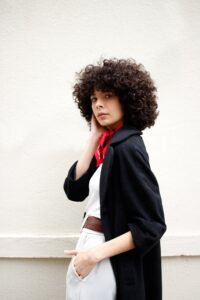The ABCs of Curls

If you have curly hair, you may have noticed that not all curls are created equal. Some are loose and wavy, while others are tightly coiled and dense. Understanding your curl pattern is essential to taking care of your hair and achieving the best results. In this guide, we’ll walk you through the different types of curls and how to care for each one.
What is a Curl Pattern?
A curl pattern refers to the shape and texture of your hair when it’s in its natural state. There are several different systems for categorizing curl patterns, but one of the most widely used is the Andre Walker Hair Typing System, which uses numbers and letters to describe different curl types.
Type 1: Straight Hair
Type 1 hair is straight and lacks any curl or wave. This hair type is typically shiny and can be thick or thin.
Type 2: Wavy Hair
Type 2 hair has a slight wave and can be divided into three subcategories:
- 2A: Fine, loose waves that can be easily straightened
- 2B: Wavy hair that tends to frizz and has a more defined S-shaped pattern
- 2C: Thick, coarse waves that are resistant to styling and prone to frizz
Type 3: Curly Hair
Type 3 hair is curly and can be further divided into three subcategories:
- 3A: Loose, springy curls with a well-defined S-shaped pattern
- 3B: Bouncy ringlets with a tighter S-shaped pattern
- 3C: Tight, corkscrew curls that are densely packed and prone to shrinkage
Type 4: Coily Hair
Type 4 hair is tightly coiled and can be divided into two subcategories:
- 4A: S-shaped coils that are tightly packed and springy
- 4B: Z-shaped coils that are tightly coiled and densely packed
Type 4 hair requires a lot of moisture and can be prone to breakage, so it’s important to use deep conditioner for natural hair to keep your curls moisturized.
Caring for Your Curl Pattern
Once you’ve identified your curl pattern, it’s important to use the right products and techniques to care for your hair. Here are some tips for caring for each curl type:
Type 1: Straight Hair
While straight hair may not have curls, it still requires care to maintain its health and shine. Use organic beauty products that are gentle and free of harsh chemicals to avoid stripping your hair of its natural oils. Regular trims can also help to keep split ends at bay and maintain your hair’s overall health.
Type 2: Wavy Hair
Wavy hair benefits from lightweight products that enhance its natural texture without weighing it down. Use natural hair oils or lightweight serums to define your waves and reduce frizz. You can also scrunch your hair with a towel or t-shirt to encourage your waves to form.
Type 3: Curly Hair
Curly hair requires more moisture than wavy or straight hair, so be sure to use organic hair products that are specifically designed for curly hair. Use a deep conditioner for natural hair to keep your curls moisturized and detangle your curls gently with a wide-tooth comb or your fingers while your hair is wet and coated with conditioner. Use a styling cream or gel to define your curls and reduce frizz. Consider protective styles such as braids or twists to reduce manipulation and breakage.
Type 4: Coily Hair
Coily hair requires even more moisture than curly hair, so be sure to use organic hair products that are rich and hydrating. Coily hair is typically more fragile than other hair types and requires extra care to prevent breakage. Avoid using brushes or combs on dry hair, as this can cause breakage and damage to the hair. Instead, use a wide-tooth comb or your fingers to detangle your hair while it’s wet and saturated with conditioner.

The Circumference of Your Curls
Another way to identify your curl pattern is by looking at the circumference of your curls. Generally speaking, there are three types of curls based on circumference: loose, medium, and tight. The circumference of your curls can be determined by measuring the width of a single curl strand.
- Loose curls: If the width of your curls is 2 inches or more, you have loose curls. These curls are often wavy and have a relaxed appearance.
- Medium curls: If the width of your curls is between 1 and 2 inches, you have medium curls. These curls are more defined than loose curls and have a bouncy appearance.
- Tight curls: If the width of your curls is less than 1 inch, you have tight curls. These curls are highly defined and can range from corkscrew curls to kinky coils.
It’s important to note that everyone’s curl pattern is unique, and you may have a combination of different curl types on different parts of your head. For example, you may have loose waves in the front of your hair and tight coils at the back.
Knowing your curl pattern is essential in choosing the right hair products and styling techniques. For instance, if you have loose curls, you may not need as heavy of a product as someone with tight coils. Also, a certain styling technique that works for someone with tight curls may not work as well for someone with loose waves.
Understand Your Hair Porosity
In addition to understanding your curl pattern, it’s important to understand your hair porosity. Hair porosity refers to the ability of your hair to absorb and retain moisture. Hair can have low, medium, or high porosity.
- Low porosity hair: If your hair has low porosity, it means that the cuticles are tightly closed, making it difficult for moisture to penetrate. As a result, hair with low porosity tends to feel dry and brittle.
- Medium porosity hair: Hair with medium porosity has a slightly more open cuticle structure, allowing for some moisture to penetrate.
- High porosity hair: If your hair has high porosity, it means that the cuticles are overly open, allowing moisture to easily penetrate but also escape quickly. Hair with high porosity tends to be frizzy and can feel dry and brittle.
Understanding your hair porosity can help you choose the right products and techniques to keep your curls hydrated and healthy.
In Conclusion
Understanding your curl pattern is essential for choosing the right hair products and styling techniques. By identifying your curl pattern and hair porosity, you can create a personalized hair care routine that will keep your curls looking and feeling their best. Remember to embrace your natural hair and treat it with care by using organic beauty products and techniques that work for your unique hair type.




